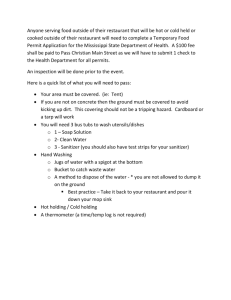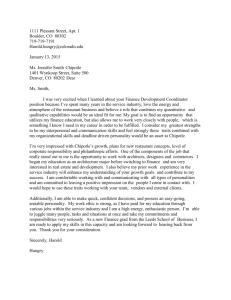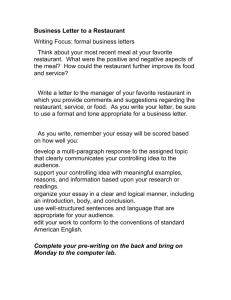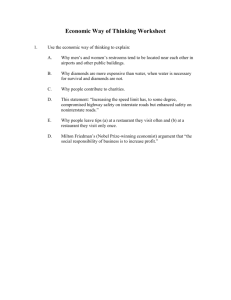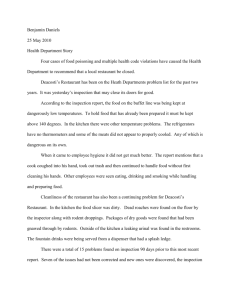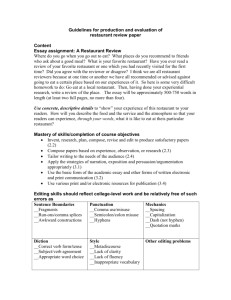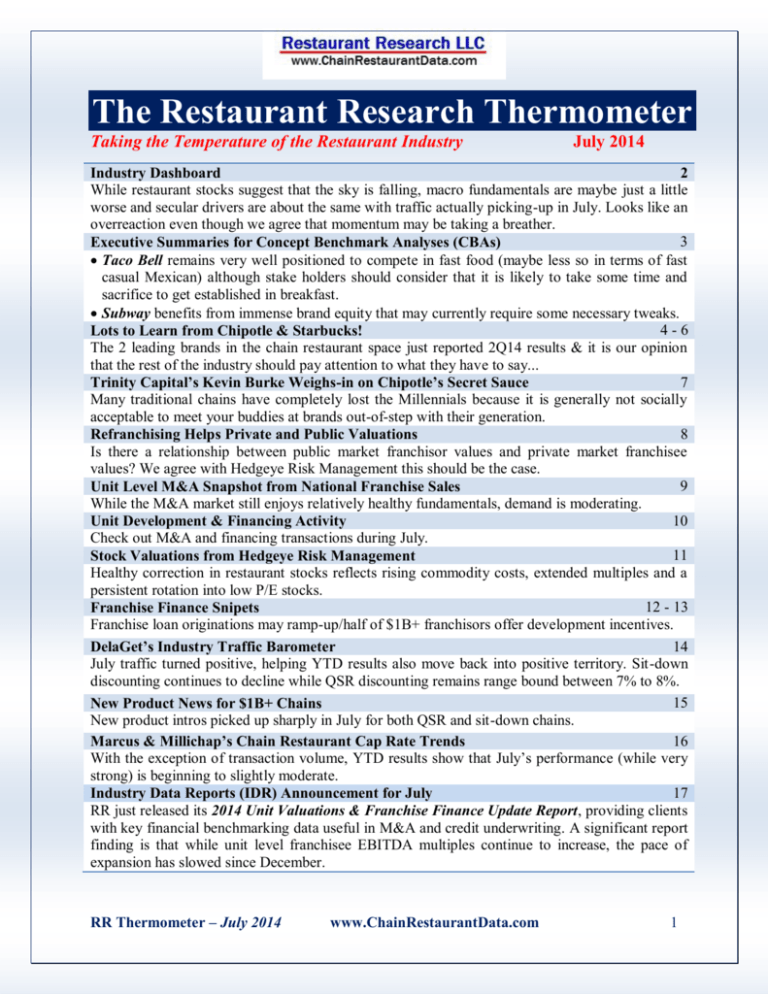
The Restaurant Research Thermometer
Taking the Temperature of the Restaurant Industry
July 2014
Industry Dashboard
2
While restaurant stocks suggest that the sky is falling, macro fundamentals are maybe just a little
worse and secular drivers are about the same with traffic actually picking-up in July. Looks like an
overreaction even though we agree that momentum may be taking a breather.
3
Executive Summaries for Concept Benchmark Analyses (CBAs)
Taco Bell remains very well positioned to compete in fast food (maybe less so in terms of fast
casual Mexican) although stake holders should consider that it is likely to take some time and
sacrifice to get established in breakfast.
Subway benefits from immense brand equity that may currently require some necessary tweaks.
4-6
Lots to Learn from Chipotle & Starbucks!
The 2 leading brands in the chain restaurant space just reported 2Q14 results & it is our opinion
that the rest of the industry should pay attention to what they have to say...
7
Trinity Capital’s Kevin Burke Weighs-in on Chipotle’s Secret Sauce
Many traditional chains have completely lost the Millennials because it is generally not socially
acceptable to meet your buddies at brands out-of-step with their generation.
8
Refranchising Helps Private and Public Valuations
Is there a relationship between public market franchisor values and private market franchisee
values? We agree with Hedgeye Risk Management this should be the case.
9
Unit Level M&A Snapshot from National Franchise Sales
While the M&A market still enjoys relatively healthy fundamentals, demand is moderating.
10
Unit Development & Financing Activity
Check out M&A and financing transactions during July.
11
Stock Valuations from Hedgeye Risk Management
Healthy correction in restaurant stocks reflects rising commodity costs, extended multiples and a
persistent rotation into low P/E stocks.
12 - 13
Franchise Finance Snipets
Franchise loan originations may ramp-up/half of $1B+ franchisors offer development incentives.
14
DelaGet’s Industry Traffic Barometer
July traffic turned positive, helping YTD results also move back into positive territory. Sit-down
discounting continues to decline while QSR discounting remains range bound between 7% to 8%.
15
New Product News for $1B+ Chains
New product intros picked up sharply in July for both QSR and sit-down chains.
16
Marcus & Millichap’s Chain Restaurant Cap Rate Trends
With the exception of transaction volume, YTD results show that July’s performance (while very
strong) is beginning to slightly moderate.
17
Industry Data Reports (IDR) Announcement for July
RR just released its 2014 Unit Valuations & Franchise Finance Update Report, providing clients
with key financial benchmarking data useful in M&A and credit underwriting. A significant report
finding is that while unit level franchisee EBITDA multiples continue to increase, the pace of
expansion has slowed since December.
RR Thermometer – July 2014
www.ChainRestaurantData.com
1
Industry Dashboard – July Overview
While restaurant stocks suggest that the sky is falling, macro fundamentals are maybe just a little worse
and secular drivers are about the same with traffic actually picking-up in July. Looks like an
overreaction even though we agree that momentum may be taking a breather.
Stock Performance
RR Thermometer – July 2014
www.ChainRestaurantData.com
2
Taco Bell
2013 US System Sales: $7.8B
2013 Growth: +4.0%
Taco Bell continues to build upon its solid positioning as the largest QSR Mexican chain, providing
a compelling and unique fast food alternative that resonates well not just with young males, but also
increasingly to a wider demographic addressed by the brand's thoughtful menu extensions. The
brand enjoys a great business model with a Mexican food platform that easily allows the mixing and
matching of simple ingredients and proteins to drive a seemingly endless pipeline of new product
news through its powerful and effective marketing juggernaut which should further benefit from an
increase in digital communication and a coming mobile platform. Breakfast represents the brand's
latest foray into ways to extend dayparts (complimenting its Happier Hour promotion) and we note
that the brand is heavily invested in its newest platform in terms of marketing, which while maybe
necessary at first, is certainly unsustainable over the long-term (reflecting the need to eventually
balance marketing support in relationship to the ratio of daypart sales). We note that breakfast is a
very tricky, long-term business given the difficulty of retraining consumers around a very ritualistic
daypart. In any case, the system's unit economics remain strong and a new remodel cycle should
help make facilities more relevant. In conclusion, it is our opinion that Taco Bell remains very well
positioned to compete in fast food (maybe less so in terms of fast casual Mexican) although stake
holders should consider that it is likely to take some time and sacrifice to get established in
breakfast.
Subway
2013 US System Sales: $12.25B
2013 Growth: +1.0%
Subway developed into an iconic brand by being first to the market with health and customization,
creating a huge base of very loyal fans. Further, the brand's industry changing $5 Footlong offer
provided even greater momentum which helped propel the system past the recession. However,
Subway's business model began to lose steam in 2013 against a backdrop of increased competition
(success has attracted a lot of attention) and rising costs which rendered the immensely important $5
Footlong platform less than optimal. Today's relevant question seems to center around how Subway
can gain wallet share from its existing customer base more so than how to attract new value seekers
with a compelling price point. To put it another way, the right question now is: how can Subway
improve its perceived value sufficiently to charge more money and to grow sales with a higher
average check? A move more towards fast casual may be required, but this will not be quick or easy
when dealing with a domestic system of almost 25,000 stores (many of which are in lower income
markets and/or not well suited to dine-in because of their small size). We like the idea of its new
Cafe format, but this vision remains in its infancy and may not be well received by operators.
Rather, we suggest that a menu fix could be more timely/appropriate and perhaps Subway should
consider upgrading its proteins for its core sandwiches (higher quality/larger portions) to better
compete at fast casual price points. Ultimately, the brand must decide whether to fight competition
from above (fast casual) or from below (QSR sandwich) or both (seems most difficult to us). In any
case, this brand can rely on its best-in-class marketing along with its ever present option to rollout
value based LTOs to buy it time while the chain considers its best long-term approach to address its
current economic/competitive backdrop. In conclusion, it is our opinion that Subway benefits from
immense brand equity that may currently require some necessary tweaks.
RR Thermometer – July 2014
www.ChainRestaurantData.com
3
Lots to Learn from Chipotle & Starbucks!
The 2 leading brands in the chain restaurant space just reported 2Q14 results & it is our opinion that
the rest of the industry should pay attention to what they have to say... Read the details of their 2Q
performance on the following 2 pages and Kevin Burke’s insight into Chipotle’s results on the page
after that.
Lessons from Chipotle
Did Chipotle really generate a +17% comp during 2Q14? Did it really put through
a +6% price increase? Is it really the most popular restaurant brand with male
teens?
This brand is most certainly doing something right! Further, it is most definitely
taking share from a host of competitors.
The entire industry should take note that Chipotle's growth is attributed to people
skills and a "unique food culture" as opposed to traditional advertising, discounting
and/or LTOs.
Lessons from Starbucks
Chipotle generated a +17% comp during 2Q14 while Starbucks took 2 years to
generate +16% comps (+9% during 2Q13 and +7% during 2Q14). Either way,
pretty impressive results...
Key Points for National Restaurant Chains to Consider:
Starbucks attributes comp growth to food sales.
The brand plans to transform tea the same way it did coffee. Now is the time for
restaurant chains to address the tea category.
Integration of mobile loyalty & payment and in-store digital experiences is creating
game-changing customer experiences which may translate into new business lines.
Drive-thrus continue to drive double digit sales growth and enhanced drive-thru
experience will include opportunity for face-to-face conversations, improvements
in ordering and payment and ability to keep-out rain in drive-thru lanes.
Company is very careful to maintain a strict 2:1 sales-to-investment ratio for new
builds.
Source: RR's Quarterly Concept Dashboard
RR Thermometer – July 2014
www.ChainRestaurantData.com
4
Chipotle 2Q14 Analysis
Qtr ended: 6/30/14
US Comps: +17.3%
Company Sales: +29%
Costs: Stabilizing
Sales
2Q14 comps grew +17.3% at nearly 1,700 stores which generate $2.3MM in AUV. Strong sales growth
is credited to restaurant managers and crews providing an exceptional dining experience which, in turn,
drives frequency and loyalty. Comp strength also reflects a unique food culture which stresses sourcing
the best ingredients (with an eye to sustainability and great taste) prepared with classic cooking
techniques.
Comps were primarily driven by traffic along with a +5% increase in check - including a +2.5% price
increase rolled-out during the quarter and +2.5% growth from: an increase in its high ticket catering
business, an increase in the group size per transaction, and sales of additional sides (Chips & Guac).
Traffic growth reflects an expanded customer base more so than a significant increase in frequency from
the brand’s core audience.
Full year 2014 comp guidance: mid-teen growth.
Menu
Sofritas are driving a 3.5% mix with an appeal beyond vegans and vegetarian customers to also include
guests who normally eat meat. This is consistent with the brand’s L-T goal of promoting vegetable diets.
Costs
The brand actually raised average prices by +6.25% to +6.5% but only measured a partial +2.5% price
increase for the quarter because the hike was implemented in late April before finishing in late June.
Based upon significant recent inflation in beef and an expectation that beef prices will remain elevated
for the foreseeable future, steak prices were raised by +9% on average while chicken prices were raised
by +5% - the brand expects that some customers will trade down from steak to chicken. Despite the price
increase, food cost were 150 bps higher than 2Q13 due to higher costs for beef, avocados and dairy.
At this time, the brand does not anticipate much more food inflation. Further, price increases are not
expected to drive much more in trade down or lost transactions. Given moderating food inflation and
sustained price increases, it is possible COGs will eventually fall to 30% from 34.6% during 2Q14.
Marketing
Purpose of marketing program is designed to encourage people to be more serious about their food and
where it comes from.
Marketing expenditures are expected to equal 1.6% of sales during 2014 and will remain elevated during
3Q as the brand continues its better ingredients ad campaign in 34 markets (1,000 stores) which will
wind-down by October. The brand uses billboards and radio ads augmented by local marketing programs
(fund raisers, etc.) to build top of mind awareness while connecting with people on an emotional level.
The company reports that it is the most popular brand with male teens.
Operations
Despite long lines at lunch and dinner, the brand drove +9.4% traffic during its peak lunch hour and
+13.3% at its peak dinner hour because of better throughput driven by: more top performing managers
and teams; the use of a linebacker during peak hours; and by better oversight and more input from field
leaders which are leveraging the system’s restaurateur diagnostic tool.
Facilities
Plans to open 180 to 195 new stores during 2014 and 70% of new stores will be in proven markets, 15%
in developing or established markets and another 15% in new markets (including Duluth, Texarkana,
Mobile and Charleston, West Virginia). New store AUV has increased +$100k to $1.7MM to $1.8MM.
Development plans call for potential sites designed for very small stores with limited seating. This
reflects a steady evolution from a mostly dine-in format 14 years ago to a 50%/50% dine-in/take-out mix
8 years ago to 2/3’s take-out currently.
RR Thermometer – July 2014
www.ChainRestaurantData.com
5
Starbucks 2Q14 Analysis
Qtr ended: 6/29/14
US Comps: +7%
Company Sales: +11%
Costs: Flat to up slightly
Sales
Fiscal 3Q comps in the US increased +7% y/y on top of +9% last year. Comp growth for the
Americas region was lower at +6% (+4% from ticket and +2% from traffic).
Strong results reflected: improved quality and variety of food offerings (food contributed +2%);
+1% in pricing; beverage innovation, including: iced teas from Teavana (Teavana Oprah Chai and
Teavana Shaken Iced Tea); Fizzio (Starbucks’ brand of preservative-free, hand crafted, cold
carbonated beverages rolled-out in ~3,000 stores in the Sun Belt region); and Frappuccino LTOs.
Menu
The brand’s investment in La Boulange and the associated rollout of new morning pastries and
products for other day parts (i.e. loaf cakes) is helping to increase the food attach rate. Food sales
are also driving margin improvement (with improvements in manufacturing costs, inventory
management and waste).
Breakfast sandwich platform delivered +40% growth in the quarter, reflecting: the nearly complete
rollout of La Boulange (with remaining stores slating to be converted by mid to late August); and
a major overhaul and upgrade of the ingredients for existing breakfast sandwiches.
New SKUs are being added to the lunch line going forward with plans to continue evolving lunch
program with a disciplined, measured approach which minimizes disruption to both store
operations and customer routines.
Hand crafted beverages are also driving afternoon & evening sales.
Evolution yogurt products (in partnership with Dannon) will be introduced in calendar 2015.
Costs for 60% of coffee needs are locked for next year (roughly flat to up slightly this year).
Marketing & Digital
Digital platforms have been instrumental in building brand loyalty and extending and deepening
customer engagement. This reflects success with cards and their associated My Starbucks Rewards
(MSR) loyalty program (8 MM+ US members). The brand is finding that “Stars” (the loyalty
program rewards currency) is highly motivating to consumers.
The core strength of its loyalty program is to fuel adoption of its mobile app (with almost 12MM
mobile app users in the U.S. and Canada). Mobile payment now accounts for 15%+ of all
transactions in U.S. company operated stores.
Forthcoming mobile order and pay initiative will allow customers to use their phones and MSR
accounts to order ahead of arriving at a store. Integration of mobile loyalty & payment and in-store
digital experiences is creating game-changing customer experiences which may translate into new
business lines.
Facilities
Drive-thrus remain a very important part of U.S. store portfolio as they continue to deliver very
strong results. They account for under 50% of company operated stores (and 50% of new stores)
and continue to drive double digit total sales growth for the 3rd consecutive year. Enhanced drivethru experience will include opportunity for face-to-face conversations, improvements in ordering
and payment and ability to keep-out rain in drive-thru lanes.
Company is very careful to maintain a strict 2:1 sales-to-investment ratio for new builds which
include new format stores & smaller footprints to address smaller markets.
RR Thermometer – July 2014
www.ChainRestaurantData.com
6
Industry Insight from Kevin Burke, Trinity Capital
Chipotle just
reported a +17%
comp for 2Q…
What is
Chipotle’s secret
sauce?
So you are saying
that it is all about
the Millennials?
What will it take
for traditional
brands to become
relevant to
Millennials? Are
there any success
stories?
Chipotle has successfully engineered its efforts toward Generation X and Generation Y
(Millennials) and most of its frequency growth is coming from Millennials. The Millennial set is
highly sensitive to what brands stand for: quality ingredients, social impact and acceptability, value
and, perhaps most importantly, “cool” factor. Restaurant chains such as Chipotle, Buffalo Wild
Wings, Taco Bell, Panera, Noodles, Café Rio, Chuy’s and a few others that have focused on this
paradigm have enjoyed recent success. Chipotle’s secret sauce is very simple: it offers fun to eat
food, healthy menu items that are made as instructed before the customer’s eyes (the way a
demanding Millennial wants it), a good atmosphere, appealing locations and good price points. If
you think about it, many of the top 25 concepts fail at applying this formula largely because of
legacy baggage. Oh yeah, and they have good music, not Muzak (Mood Media)!
Many traditional chains have completely lost the Millennials because it is generally not “cool”
(socially acceptable) to tweet/text/Facebook your buddies and ask them to meet you at brands outof-step with their generation. You get it? Things are changing rapidly with respect to: 1)
demographics, 2) consumer discretionary spending, 3) new formation of households, 4) employment
and 5) consumption. The economy today is producing winners and losers among various
demographic groups. Millennials dine out frequently and they are loyal customers. This is quietly,
but steadily shaking up the restaurant business; however, a lot of people are not talking about
it. Many “traditional” brand restaurant executives largely don't get it and are suffering predictably
consistent transaction-count losses particularly among younger demographics. Consider this: Knapp
Track casual dining transaction counts have been negative for 58 of the last 66 months. There's both
economics and consumer behavior encompassed in that trend!
In order to attract Millennials in any meaningful quantity and frequency, the traditional brands will
have to relaunch or “reset” their brands toward Millennials with respect to: restaurant image,
signage, healthy fare, advertising messages and customer base. Millennials are not going to want to
go into an old building with unhealthy food and demographically incongruent patronage (uncool
customers). These brands know who they are, but it is very difficult, expensive and time-consuming
to change your stripes and it involves the risk of alienating your existing customer base. One
example of a success story is the meteoric success of Taco Bell with its social media efforts and
dominance of the Millennial set. This was a thoughtfully orchestrated strategic move that involved
products, promotion, dayparts and social media. Taco Bell is now number two with Millennials
next to Chipotle and ahead of Starbucks!
Every day thousands of traditional restaurant brand customers retire and start to pinch pennies. This
involves reducing restaurant visits, which hurts the transaction counts of many of the traditional
restaurant brands. Let's face it, the nation's oldest restaurant chains have to find a way to replace
their retiring and/or dying customers. Some of them are not yet up to the challenge!
Trinity Capital LLC
11755 Wilshire Blvd., Suite 2450
Los Angeles, CA 90025
Main: 310-268-8330
Direct: 310-231-3100
kburke@trinitycapitalllc.com
Mr. Burke is the founder and Managing Partner of Trinity Capital. Since its inception in
2000, Trinity Capital has completed over $10 billion in mergers and acquisitions, financial
restructurings and financing transactions for restaurant companies. Clients have included
such corporations as Taco Bell, Burger King, Ready Pac, Green Earth Fuels and Yum!
Brands and such private equity firms as The Carlyle Group, Bain Capital, the Thomas H.
Lee Company and Goldman Sachs Capital Partners.
RR Thermometer – July 2014
www.ChainRestaurantData.com
7
Refranchising Helps Private and Public Valuations
Is there a relationship between public market franchisor values and private market franchisee
values? We agree with Hedgeye Risk Management's conclusion in our recent Think Piece that
this should be the case.
As we can see from the chart below, public franchisor EV/EBITDA multiples have
steadily increased relative to private franchisee EBITDA multiples since the 2008
recession - although we note that they have both increased on an absolute basis.
"Asset light" refranchising strategies have certainly helped this trend as franchisors have
traded store operating margin risk to franchisees in exchange for steady and profitable
royalty stream margins. This strategy can work well for franchisees who are looking for
as many stores to own and operate as possible. Also, we suggest that this trend helps
strengthen systems given that franchisees are often better store operators.
While higher public and private multiples reveal a win/win scenario, we suggest that
leaving store management to privately held franchisee operators means that the health of
the franchise system is more important than ever to overall brand health.
Sources: RR’s Unit Level Valuations Report & Hedgeye Risk Management
RR Thermometer – July 2014
www.ChainRestaurantData.com
8
Unit Level M&A Snapshot from National Franchise Sales
While the M&A market still enjoys relatively healthy fundamentals, demand is moderating.
July 2014
Score
(5 increasing – 1 decreasing)
Buy-side Demand
3↓
Sell-side Supply
4
Financing Availability
3↓
Valuation Multiples
4
1
2
3
4
5
Comments
High confidence in specific brand’s performance
combined with low returns on liquidity continue to
fuel interest, but not quite on pace with sell side
supply.
Sellers are taking advantage of strong multiples and
buyer’s access to new debt.
While there is a large number and variety of available
lenders, loan capacity is being constrained by
workloads. This may result in some tightening of
requirements.
Multiples remain strong in response to demand levels
and plentiful acquisition debt.
Buy-side Demand
Sell-side Supply
Financing Availability
Valuation Multiples
SPECIALIZING IN THE RESALE OF FRANCHISE BUSINESSES SINCE 1978
National Franchise Sales has become an industry leader in franchise business brokerage by successfully
assisting franchisees and franchisors in the acquisition and sales of their businesses, since 1978.
Active in over fifty brands, NFS has facilitated numerous transactions from the sale of a single unit franchise
to multi-unit sales involving over 100 units, and the sale of franchise companies. Headquartered in Newport
Beach, CA with ten offices Nationwide, NFS is staffed by over 20 industry professionals.
Alan F. Gallup
National Franchise Sales
RR Thermometer – July 2014
949.428.0483
www.ChainRestaurantData.com
9
Unit Development & Financing Activity during July 2014
M&A and financing transactions during July from RR’s Unit Development & Financing Activity
Database is outlined below. Clients can find complete database with development deals online.
Source: Restaurant Research Development & Financing Activity Database
RR Thermometer – July 2014
www.ChainRestaurantData.com
10
Stock Valuations from Hedgeye Risk Management
Healthy correction in restaurant stocks reflects rising commodity costs, extended multiples and a
persistent rotation into low P/E stocks.
July was a difficult month for restaurant stocks as the vast
majority of the industry was hampered by multiple
contraction.
Pizza is the only restaurant segment that saw multiple
expansion in the period, as Domino’s reported strong, above
consensus 2Q14 earnings.
The fine dining segment, which we flagged as a positive
outlier in June, experienced a sharp correction in July as Del
Frisco’s reported disappointing 2Q14 results.
Howard Penney
Managing Director
HEDGEYE RISK MANAGEMENT
(O) 203-562-6500
(C) 862-217-9429
(E) HPenney@hedgeye.com
RR Thermometer – July 2014
www.ChainRestaurantData.com
11
Franchise Loan Originations are Poised to Ramp-Up
According to Restaurant Research's just completed Restaurant Finance Lender Survey
(included in just released RR's Unit Level Valuations Report), loan originations are
poised to continue increasing.
We believe this has positive implications for both enterprise and real estate valuations.
Source: RR’s Unit Level Valuations Report
RR Thermometer – July 2014
www.ChainRestaurantData.com
12
The Answer to Slowing Gross New Unit Development?
Development Incentives…
Nearly half of $1B+ franchisors offer development incentives.
Source: RR's 2014 New Build Costs & Franchise Fees Report
RR Thermometer – July 2014
www.ChainRestaurantData.com
13
DelaGet’s Industry Traffic Barometer
July traffic turned positive, helping YTD results also move back into positive territory. Sit-down
discounting continues to decline, while QSR discounting remains range bound between 7% to 8%.
DelaGet transaction data for large brands is aggregated
from 4,000+ QSR and 1,700+ sit-down locations
Note: In some cases, gross sales includes sales tax
Source: DelaGet
DelaGet is a trusted partner of multi-unit restaurant operators around the world, servicing more than 10,000
restaurants and processing data associated with more than four billion order items annually. By centralizing and
consolidating the data from numerous point-of-sale, back-of-house, banks, suppliers, drive-thru timers, etc., DelaGet
leverages the data to increase operator efficiency and profitability through its above-store reporting; data integration;
loss prevention; marketing measurement and planning; payroll processing; and general ledger accounting services.
Learn more at www.DelaGet.com.
RR Thermometer – July 2014
www.ChainRestaurantData.com
14
New Product News for $1B+ Chains
New product intros picked up sharply in July for both QSR and sit-down chains.
Sandwich chains introduced the largest number of new products with a focus on burgers.
Taco Bell led the way with its low priced Grilled Breakfast Burrito line and Cantina Power
Menu additions.
Weekday discounting heated up in the pizza segment with Papa John’s new Early Week
Mania (large 2 topping pizza - $8.99 Mon. – Wed.) which will compete with Domino’s Mon.
– Thur. Carry-out Deal (large 3 topping pizza - $7.99) and Pizza Hut’s Digital Deal (large 2topping pizza - $7.99). Papa John’s continues to maintain its $1/pizza premium.
Domino's increased the price on its med. 2 topping pan pizza from $7.99 to $8.99 in July.
KFC stepped-up its value offer with the $5 Fill-ups promotion which includes a single choice
of 5 entrees, side, biscuit, cookie and drink, all for $5.
Source: Restaurant Research Menu & Promotions Database
RR Thermometer – July 2014
www.ChainRestaurantData.com
15
Marcus & Millichap’s Chain Restaurant Cap Rate Trends
July was a busy month, with transactions up +39% y/y.
Cap rates declined -5% y/y to 6.51% (just above June’s recent low) and median price per s.f.
increased +7.6% y/y, once again reflecting the ongoing strength in this asset class.
With the exception of transaction volume, YTD results show that July’s performance (while very
strong) is beginning to slightly moderate.
Source: The Nisbet Group has been specializing in the disposition and acquisition of Net-Leased properties for
the past 15 years under the expertise of Peter Nisbet, the managing partner. By focusing exclusively on the
restaurant product type, The Nisbet Group has formed an unmatched understanding of the unique challenges that
transpire during a transaction while creating solutions to overcome them. The team is recognized as a market
leader for their superior service and outstanding performance by routinely displaying their skills at analyzing
market trends, evaluating properties and resolving issues across the transaction process. This dedicated group
has closed escrow on over 300 properties; earning clients more than $500 million. The Nisbet Group’s success is
made possible through the deployment of market segmentation, innovative approaches, detail orientation, and
cultivated relationships. The group is able to deliver unmatched service to their clients year after year.
For more information please contact Hank Wolfer of The Nisbet Group at (206) 826-5730
RR Thermometer – July 2014
www.ChainRestaurantData.com
16
RR’s July Industry Data Reports (IDR) Announcement
RR just released its 2014 Unit Valuations & Franchise Finance Update Report, providing clients with
key financial benchmarking data useful in M&A and credit underwriting. A significant report finding
is that while unit level franchisee EBITDA multiples continue to increase, the pace of expansion has
slowed since December.
Unit Valuations &
Franchise Finance Update Report
RR’s Valuation Industry Data Report provides: (1) EBITDA multiple estimates (post G&A)
for 38 chains based on survey data from 6 leading appraisal firms (responsible for ~2,600 store
valuations over the last 6 months); (2) a comparison of public restaurant company and private
franchisee valuation multiples; (3) a summary of real estate cap rate trends based on data
provided by Marcus & Millichap; and (4) an update on the current state of restaurant finance
derived from a survey of leading lenders which focuses on restaurant loan origination volume,
borrower financial condition, changes to underwriting standards and interest rate outlook.
Report highlights: (1) unit level franchisee EBITDA multiples continue to increase, but the
pace of expansion has slowed since December while casual and fast casual multiples contracted;
(2) public franchisor EV/EBITDA multiples have steadily increased relative to private franchisee
EBITDA multiples since the 2008 recession; (3) cap rates for single-tenant net-leased restaurant
properties continued to decline to new lows; and (4) restaurant financing remains favorable for
franchisees due to competition among lenders, low rates and stable terms.
For more info on this report, please visit
www.ChainRestaurantData.com or contact us at
(203) 938-4703 or info@ChainRestaurantData.com
RR Thermometer – July 2014
www.ChainRestaurantData.com
17
Learn More about Client Services
www.ChainRestaurantData.com
Please Pass to Your Colleagues
Copyright: This Restaurant Research LLC document is copyrighted material. Copyright 2014 Restaurant Research® LLC. All rights reserved.
Disclosure: Restaurant Research LLC often sells report subscriptions to concepts under our coverage.
Disclaimer of Liability: Although the information in this report has been obtained from sources Restaurant Research® LLC believes to be reliable, RR does not guarantee its accuracy. The views
expressed herein are subject to change without notice and in no case can be considered as an offer or solicitation with regard to the purchase or sales of any securities. Restaurant Research’s
analyses and opinions are not a guarantee of the future performance of any company or individual franchisee. RR disclaims all liability for any misstatements or omissions that occur in the
publication of this report. In making this report available, no client, advisory, fiduciary or professional relationship is implied or established. This report is intended to provide an overview of the
restaurant industry, but cannot be used as a substitute for independent investigations and sound business judgment.
RR Thermometer – July 2014
www.ChainRestaurantData.com
18

